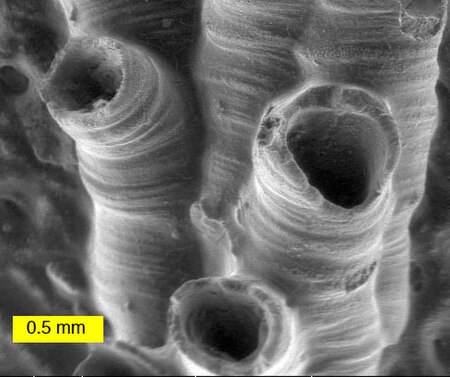IntroductionThe Devonian (/dəˈvoʊni.ən, dɛ-/ də-VOH-nee-ən, deh-) is a geologic period and system of the Paleozoic era during the Phanerozoic eon, spanning 60.3 million years from the end of the preceding Silurian period at 419.2 million years ago (Ma), to the beginning of the succeeding Carboniferous period at 358.9 Ma. It is named after Devon, South West England, where rocks from this period were first studied. The first significant evolutionary radiation of life on land occurred during the Devonian, as free-sporing land plants (pteridophytes) began to spread across dry land, forming extensive coal forests which covered the continents. By the middle of the Devonian, several groups of vascular plants had evolved leaves and true roots, and by the end of the period the first seed-bearing plants (pteridospermatophytes) appeared. This rapid evolution and colonization process, which had begun during the Silurian, is known as the Silurian-Devonian Terrestrial Revolution. The earliest land animals, predominantly arthropods such as myriapods, arachnids and hexapods, also became well-established early in this period, after beginning their colonization of land at least from the Ordovician period. (Full article...) Selected article on the Devonian world and its legacies There are approximately 5×1030 bacteria on Earth, forming a biomass that exceeds that of all plants and animals. Bacteria are vital in recycling nutrients, with many steps in nutrient cycles depending on these organisms, such as the fixation of nitrogen from the atmosphere and putrefaction. In the biological communities surrounding hydrothermal vents and cold seeps, bacteria provide the nutrients needed to sustain life by converting dissolved compounds such as hydrogen sulphide and methane to energy. Most bacteria have not been characterised, and only about half of the phyla of bacteria have species that can be grown in the laboratory. The study of bacteria is known as bacteriology, a branch of microbiology. Unlike cells of animals and other eukaryotes, bacterial cells do not contain a nucleus and rarely harbour membrane-bound organelles. (see more...) Did you know?
Need help?Do you have a question about Abyssal/Portal:Devonian that you can't find the answer to? Consider asking it at the Wikipedia reference desk. Selected image
Selected article on the Devonian in human science, culture and economics
The history of paleontology traces the history of the effort to study the fossil record left behind by ancient life forms. Although fossils had been studied by scholars since ancient times, the nature of fossils and their relationship to life in the past became better understood during the 17th and 18th centuries. At the end of the 18th century the work of Georges Cuvier ended a long running debate about the reality of extinction and led to the emergence of paleontology as a scientific discipline.
The first half of the 19th century saw paleontological activity become increasingly well organized. This contributed to a rapid increase in knowledge about the history of life on Earth, and progress towards definition of the geologic time scale. As knowledge of life's history continued to improve, it became increasingly obvious that there had been some kind of successive order to the development of life. After Charles Darwin published Origin of Species in 1859, much of the focus of paleontology shifted to understanding evolutionary paths. The last half of the 19th century saw a tremendous expansion in paleontological activity, especially in North America. The trend continued in the 20th century with additional regions of the Earth being opened to systematic fossil collection, as demonstrated by a series of important discoveries in China near the end of the 20th century. There was also a renewed interest in the Cambrian explosion that saw the development of the body plans of most animal phyla. (see more...) GeochronologyEpochs - Early Devonian - Middle Devonian - Late Devonian Landmasses - Baltica - Laurentia - Euramerica - Gondwana Fossil sites - Grenfell fossil site History - The Great Devonian Controversy SubcategoriesQuality ContentFeatured Devonian articles - None Things you can doRelated contentAssociated WikimediaThe following Wikimedia Foundation sister projects provide more on this subject:
|




















